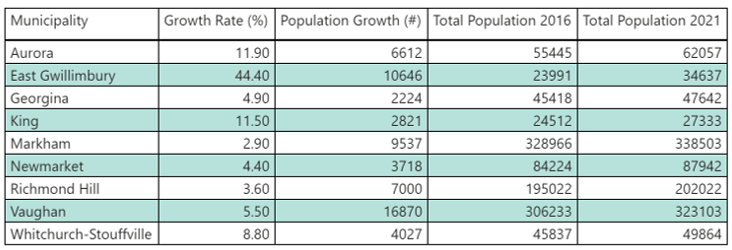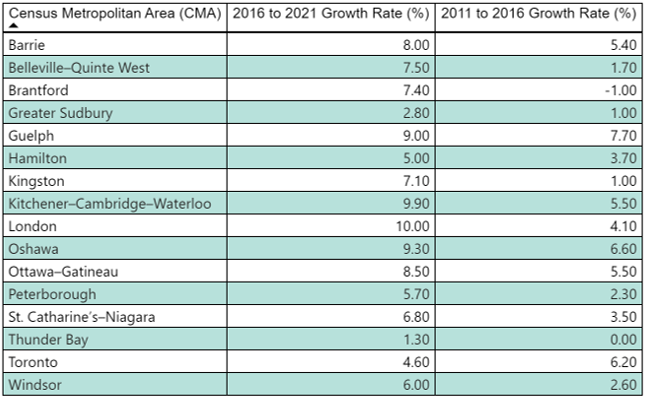2021 Census Insights and Findings – Population and Dwellings
Key Highlights
- Vaughan was the fastest growing City in York Region with a population growth rate of 5.5%, totalling 323,103 residents in 2021
- York Region’s population has increased 5.7% since 2016, totalling 1,173,334 residents in 2021
- Canada remains the fastest growing nation in the G7, with a population in 2021 of 36,991,981, a 5.2% increase over 2016
- 3 million people are living in one of Canadas 41 urban centres
- Since 2016, four-fifths of Canada’s population growth is directly attributed to immigration
- Ontario grew at a faster pace than Canada overall at 5.8% totalling 14,223,942 residents in 2021
- Ontario welcomed twice has many immigrants into the province than the previous census period (2011 to 2016)
- All major Census Metropolitan Areas (CMAs) in Ontario have recorded the same or higher growth rates since the last census period – as of 2021, Toronto CMA has grown by 4.9% since 2016, 1.6% lower than growth seen in the previous census period
Insights and Findings
Canada
Canada remains the fastest growing Country in the G7 with a population that has grown 5.2% since 2016 and now totals 36,991,981. Our population continues to urbanize, with close to 27.3 million people living in one of Canada’s 41 urban centres. Immigration has contributed heavily to Canadas population growth since 2016 as nearly four-fifths of population growth are directly attributed to immigration.
Ontario
The population of Ontario grew at a faster pace than Canada, reporting 14,223,942 residents in 2021. This represents a growth rate of 5.8% from the previous census. The growth in Ontario’s population was mainly attributed to immigration with twice as many permanent and temporary immigrants being welcomed into the province then the previous census period (2011-2016). Population growth within Ontario’s major urban centres have continued to experience significant growth, figure 1 below shows the growth rates for major census metropolitan areas (CMA) within Ontario during the last two census periods. All major CMA’s have shown increased levels of growth since the last census period except for the Toronto CMA which recorded a 1.6% decrease in growth rate since the last census period. Toronto CMA’s growth rate is still positive for 2021 at 4.6%.
Figure 1: Ontario Major Urban Centres (CMA) Growth Rate (%) 2016-2021 and 2011-2016
Toronto Census Metropolitan Area (CMA)
The Toronto Census Metropolitan Area which includes twenty-four municipalities saw a 4.6% increase in population between 2016 and 2021 with a total population of 6,202,225 residents. The largest cities within the CMA have experienced positive growth (except for Mississauga at -0.5%). Figure 2 below highlights the population growth rates and changes of cities within the Toronto CMA.
Figure 2: Toronto CMA Population Growth Rate and Change by City 2016-2021

York Region
York Region’s population has grown by 5.7% from 2016 to 2021, reporting 1,173,334 residents. Towns and townships in the region all saw significant increases in population between 2016 and 2021, with urban centre growth rates led by Vaughan. Figure 3 below provides the growth rates and change in population between 2016 and 2021 for York Region municipalities.
Figure 3: York Region Population Growth Rate and Change by Municipality 2016-2021

Vaughan
Vaughan’s population grew by 5.5% from 2016 to 2021, now totalling 323,103 residents. The City’s dwelling count has increased by 10,502, totalling 107,159 dwellings in 2021 The City’s Overall population density since 2016 has increased by 66.5 residents, now sitting at 1,185 residents per square kilometer in 2021. More information on dwelling counts, demographics, labour and more will be presented to Council upon release by Statistics Canada. Please see future release dates specified below by topic.
2021 Census Release Schedule
Statistics Canada will release 2021 Census topics throughout 2022. Economic Development will continue to monitor and provide council with information on Vaughan’s growing demographics and economy.
- April 27th, 2022 – Age, sex at birth and gender; type of dwelling
- July 13th, 2022 – Families, households, and marital status; Canadian military experience; income profiles
- August 17th, 2022 – Language
- September 21st, 2022 – Indigenous peoples, and housing
- October 26th, 2022 – Immigration, place of birth, and citizenship; ethnocultural and religious diversity; mobility and migration
- November 30th, 2022 – Education, labour, language of work, commuting, and instruction in the official minority language

